10 shopping tips for finding a great engagement ring
Trends fade, but the perfect rock lasts forever
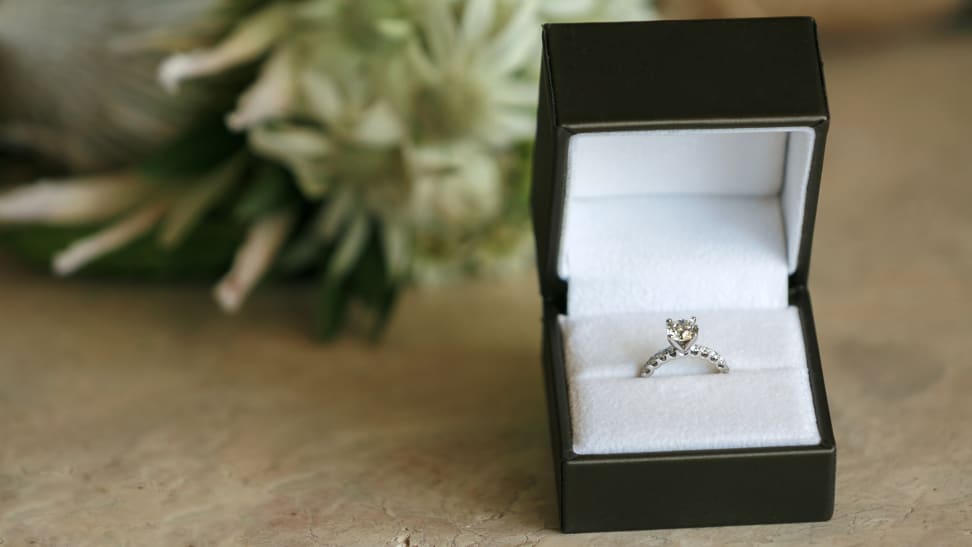 Credit:
iStock / Getty Images
Credit:
iStock / Getty Images
Recommendations are independently chosen by Reviewed's editors. Purchases made through the links below may earn us and our publishing partners a commission.
When it comes to proposing, romance is key. But when you’re buying an engagement ring, you might want to leave the fairy tales at the door, as it’s important to remember that these rocks are a serious financial investment too, and you can get the most bang for your buck if you play it smart.
“Purchasing an engagement ring online is the best way to save on your ring,” said Ria Papasifakis, vice president of revenue at Ritani, a fine jewelry company specializing in engagement rings and bridal accessories. “Online jewelers don’t have to deal with the same overhead that brick-and-mortar jewelers face, which gives them the ability to offer lower prices.”
Whether you’re shopping for sparklers solo or doing it with your partner, approaching the purchase with a strategy can help you save time, reduce stress, and still find the perfect fit. This list of shopping do’s and don’ts includes expert tips to help you understand everything you need to know before you buy an engagement ring.
1. Set your budget—and stick with it
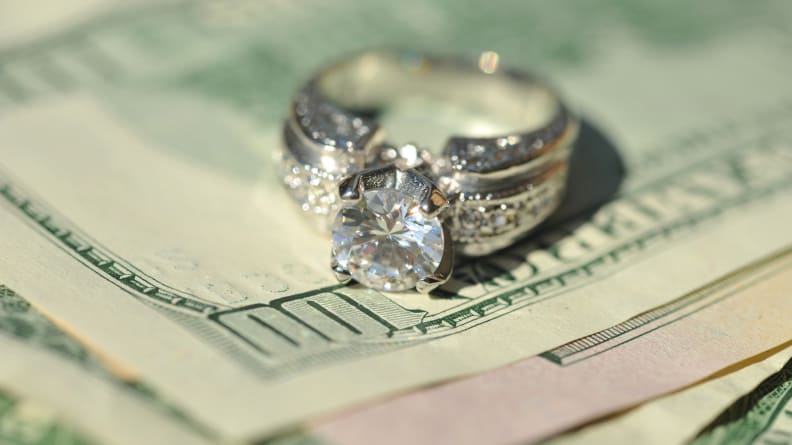
Forget the three months' salary rule. Experts recommend just sticking to what you can reasonably afford.
The average amount spent on an engagement ring in the U.S. is $5,225, according to a 2021 survey by Ringspro, an engagement ring guidance website. But that doesn’t mean you have to spend thousands of dollars on one—in fact, most experts agree that there aren’t any rules around how much you should spend on an engagement ring, except for one: Don’t spend more than you can afford.
“[Before shopping,] I suggest customers first set their hard budget,” said Apeksha Kothari, chief operating officer at Rare Carat, an online diamond marketplace. “Look around your social circles, consider [your partner’s] expectations, but don’t go crazy. Keep in mind you’re never going to resell this diamond for more than you bought it for, and you can always upgrade later.”
Once you have a budget in mind, stick with it. Knowing how much you can reasonably invest can make you far more likely to make smarter shopping decisions and avoid common pitfalls, like using a credit card to finance the purchase, which most experts advise against.
2. Use the 4C’s to your advantage
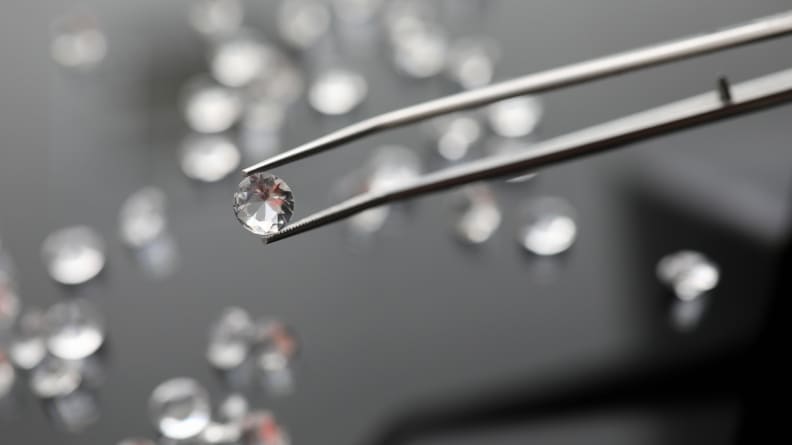
Learning about the 4C’s—cut, color, clarity, and carat—can help you find a great diamond.
The 4C’s—cut, color, clarity, and carat—can tell you a lot about a diamond, and function as an overall grading system that can impact the price of an engagement ring. Understanding what each of them means can help you see past the glitz and judge your love’s future bling with a more critical eye, which is crucial if you’re trying to make a savvy purchase.
“Most engagement ring shoppers focus on two things, the size of the diamond and the sparkle it gives off,” said Tori Dundas, founder of True Curated Designs, a fine jewelry shop specializing in engagement rings and bridal accessories. According to her, a well-cut diamond is more likely to reflect light and helps ensure a diamond appears true to size, so it’s not “hiding carat weight in the wrong places.”
While cut matters, it’s not the only aspect of the 4 C’s to consider as you’re shopping, noted Dundas, as clarity can have a significant influence in ways you might not expect. “The term ‘eye clean’ means that the inclusions in a diamond cannot be seen [by] the naked eye, and therefore will not impact its brilliance. Opting for a clarity rating that is ‘eye clean’ is a great way to get more value,” she added.
Color is another biggie. The Gemological Institute of America (GIA) has a color scale that’s used across the industry to grade hues, and diamonds rated as D, E, or F are considered “colorless,” while those with a G, H, or I rating are deemed “near-colorless.” Dundas noted that while relevant to the diamond’s value, many average shoppers can’t see the difference, so opting for a near-colorless rock might save you more money overall.
Additionally, she urges shoppers to follow the 0.99 rule when it comes to looking at carat weight. “The price of a diamond often jumps into a higher bracket as soon as you hit the next, full carat weight,” said Dundas. “This added premium is due to the psychological impact created by the first digit. However, the difference in measurement between a 1.9 and a 2.0-carat diamond will be almost negligible.”
3. Find the right retailer

Shopping online for engagement rings is an easier way to compare various styles and prices, without having to go to multiple stores.
When you’re ready to start officially searching, you might be tempted to head directly to the first local jewelry store you can find and call it a day. But shopping online for engagement rings opens up a world of possibilities—and potential savings—for couples.
The best places to buy engagement rings online can help you compare various styles and browse from the comfort of your own home. You can also open fresh tabs in your browser and shop multiple retailers at once, which can save you a ton of time. If you’re shopping during the summer and early fall—traditionally seen as “off-season,” according to experts—you may also find great deals on rings that you wouldn’t during the holiday season, specifically Christmas, as this is usually considered the most popular time to buy rings.
Popular online retailers like Blue Nile and Brilliant Earth also allow you to look at photos and more, so you can get a real look at what you’re getting. Additionally, many online retailers offer the option to buy loose stones and/or custom design options, so you can add an extra-special touch and let your partner know how much this ring really comes from the heart.
4. Take your partner’s style into account—and include them

Shopping for rings together can be a great way to bond with your partner—and find a ring you know they'll love.
Some partners may drop hints when they’re eager to get engaged, but others may be more subtle. If you’re unsure what kind of ring your love would prefer, it may be helpful to ask their best friend or a close relative for suggestions. However, some experts think you should avoid using an in-between and just go directly to the source. “Don't bring a friend, ask for your partner's input,” said Kothari. “If you get a princess-shaped diamond and she was set on a round, it’s going to be an awkward 50 years.”
Pinterest can be a great way to get ideas, if your partner is active on the site. Another option, of course, is to just go shopping with them directly. While some might want to avoid this because they’d rather plan for a surprise romantic proposal, there are definite benefits to browsing for rings directly with them, as you’ll have less anxiety about whether or not they’ll like the ring.
A scenario where you could get the best of both worlds is to have your partner narrow down their list of favorites to three or four, and then make the final purchase yourself—that way, you can still plan a tender, intimate proposal when they’re least expecting it.
5. Choose a diamond shape with care
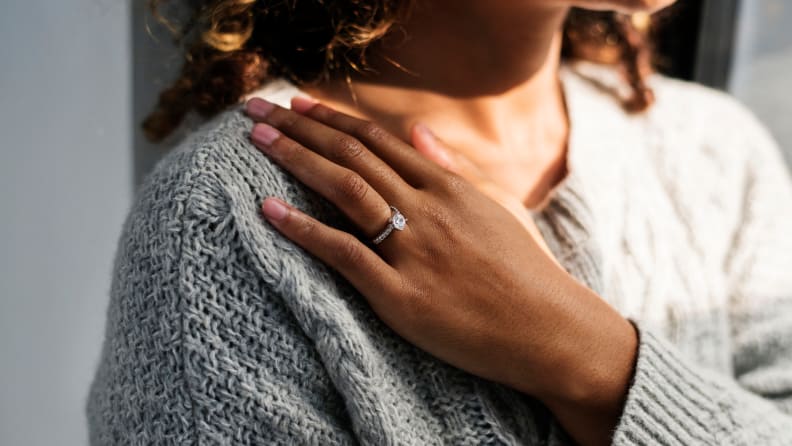
A round diamond is the most popular shape, but experts say it's also the most expensive.
If you’re shopping for a diamond, its shape is something your partner is likely to feel very passionate about, so it’s important to find that out before you buy anything. But if they don’t have a preference, there are plenty of options to choose from, including round, oval, emerald, princess-cut, and others.
The most popular diamonds, according to experts, are round-shaped, but bear in mind, they’re also the most costly. “Round [diamonds are] the most expensive per carat because of the sheer demand for this classic shape,” said Kothari. According to Dundas, that’s not the only reason they command a higher price, however. “Round diamonds involve more time and skill to cut, and they also require that more of the rough diamond is cut away in order to achieve its fire and brilliance, therefore reducing overall carat weight,” she said.
If you’re looking for the best value—and also, assuming your partner doesn’t have their heart set on a round diamond—you may want to think outside the box (or circle, as it were). “To save on your engagement ring, choose fancy-shaped diamonds, such as oval-cut diamonds, emerald-cut diamonds, or princess-cut diamonds. Not only are these shapes beautiful and trendy, but they are much less expensive than round-cut diamonds,” said Papasifakis.
According to Papasifakis, these unique diamond shapes can also appear larger than other diamonds of the same carat weight due to their larger surface area.
6. Select a setting that works with the diamond—not against it
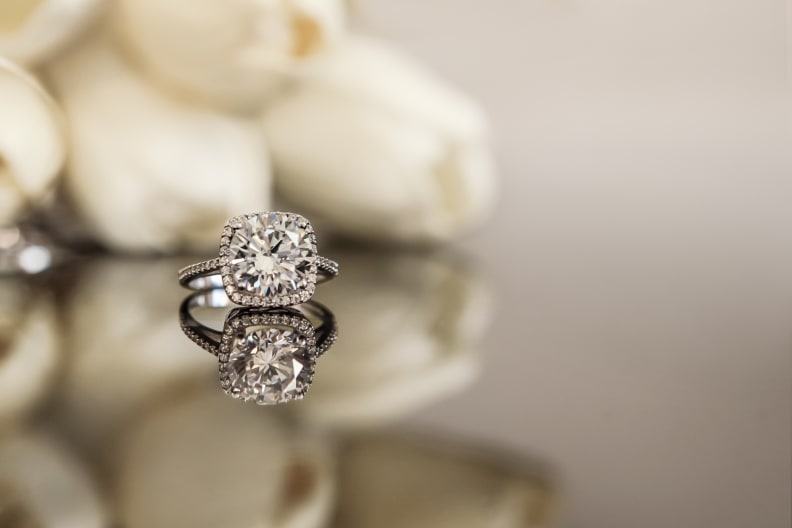
A halo setting can help accentuate a center stone, giving it an even more radiant look.
Aside from the shape, a setting is one of the most aesthetically important aspects of an engagement ring. The right setting not only cushions and supports a diamond (or other gemstone you might choose), but it can also complement the rock in dazzling ways.
A thin solitaire setting is a timeless style wherein the center stone is held in place by prongs, typically four to six, and can be a great choice to pair with a round diamond because it draws all focus right to it. Bezel, halo, three-stone, and side-stone settings are also common options for settings, although some may have a steeper price tag than others.
“Large stones are more expensive on a per-carat basis than small stones. This means that adding significant side stones to a ring will increase the price more than using smaller stones for embellishment,” said Dundas.
If you’re looking for a way to accentuate a center stone, Dundas recommended going with halo settings or using melee diamonds—also known as accents or diamond chips, and commonly used as side stones or in clusters—to create an impact.
7. Weigh your options for metals
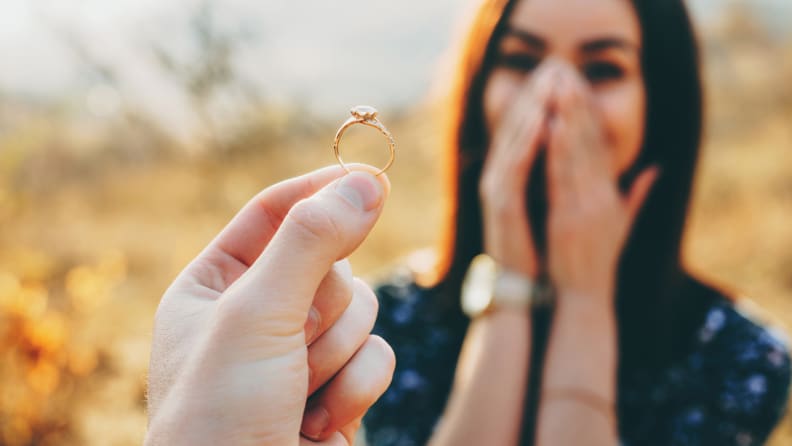
The metal you choose for an engagement ring can be just as essential as the shape of the diamond itself.
Yellow gold isn’t the only metal you can choose from when you’re looking at engagement ring settings—other popular colors include platinum, palladium, silver, white gold, and rose gold. However, some metals are pricier than others.
Platinum has a sleekness to it that can be appealing to the modern bride or groom and is also hypoallergenic (meaning it may be ideal for those with sensitive skin), but it’s also the most expensive metal. White gold or silver, which are similar in look to platinum, are significantly more affordable and may be a better option for budget-conscious shoppers, noted experts.
Beyond cost, there are other things to consider, like how the metal will look with the gemstone used in the ring. “Diamonds set in yellow gold tend to absorb the color of the gold, so the difference between a G diamond and a K diamond will be almost imperceptible,” said Dundas.
8. Don’t stress the imperfections
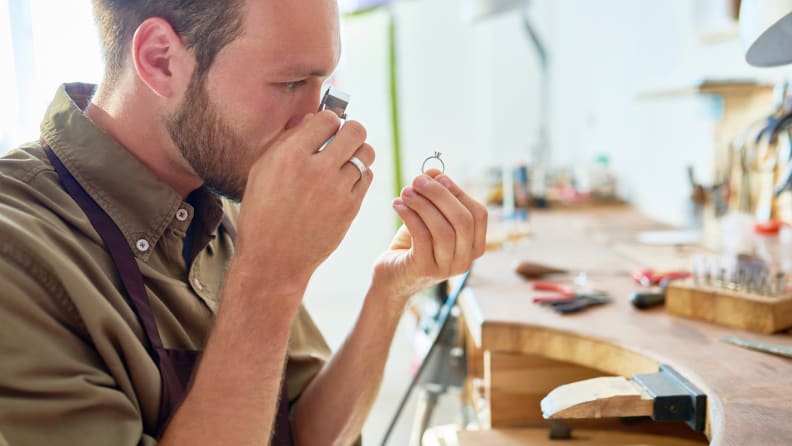
A diamond without inclusions is rare, so don't worry about having some in the rock you purchase.
It’s easy to fall for the hype surrounding engagement rings and to especially feel a lot of pressure when it comes to diamond quality. If you’ve found a great stone that’s in a shape your partner loves and fits your budget, but you’re hesitant to buy it because it has inclusions (i.e., irregularities inside the diamond, which are often only visible under a microscope), experts urge you to reconsider, particularly if you’re trying to be a smart shopper.
“The closer a diamond gets to being flawless, the more rare it becomes, and rarity can come at a significant cost,” said Dundas. “Subtle imperfections create the unique, defining features of a diamond. Why not select a diamond as distinctive and unique as your partner is?”
9. Always buy certified—and get everything in writing

GIA or AGS certification is a gold standard across the diamond industry.
Beyond the ins and outs of the engagement ring itself, there are a few practical considerations to keep in mind as you shop. One of the biggest is making sure the diamond is certified by either GIA or the American Gem Society (AGS).
Major chains like Zales have accreditation, but if you’re looking at rings through a specialty shop on Etsy, it’s more of a concern, so be sure to do your due diligence.
Another thing worth looking into is engagement ring insurance, as this can help protect your investment in the event of theft, loss, or significant damage. Large retailers like Kay Jewelers may offer in-house programs for insurance, but you can also get policies through outside insurers, such as Jewelers Mutual, Geico, and others.
10. Be patient—and take your time

Start researching engagement rings anywhere from six months to a year before you plan to propose.
In most cases, you want to have an engagement ring in advance of popping the question, but it’s not a hard-and-fast rule, especially if you’re shopping with your partner. But if you do intend to keep it a secret, experts recommend giving yourself plenty of wiggle room.
It’s a good idea to start researching engagement rings anywhere from six months to a year before you propose, and giving yourself a space of about two to three months between when you buy the ring and when you’ll actually get it, if you’re shopping online or doing something custom.
But if you’re not finding that one great ring that really matches your partner’s taste and stands out, don’t freak out. Remember, this process is as important for you as it is for them, and it can be stressful, so don’t be afraid to relax, self-care, and extend your deadlines a little bit. After all, the right ring—much like the right life partner—is worth waiting for.
The product experts at Reviewed have all your shopping needs covered. Follow Reviewed on Facebook, Twitter, and Instagram for the latest deals, product reviews, and more.

